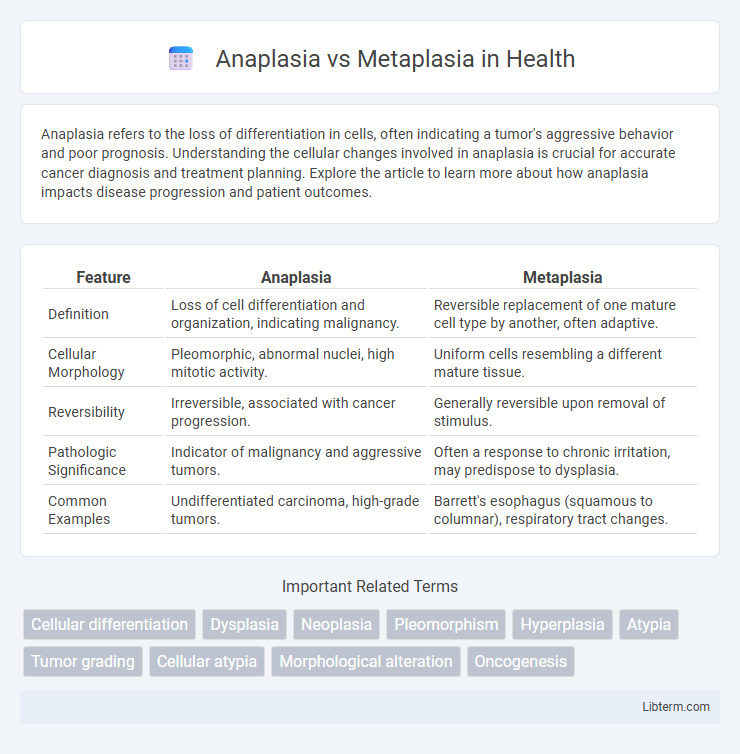Anaplasia refers to the loss of differentiation in cells, often indicating a tumor's aggressive behavior and poor prognosis. Understanding the cellular changes involved in anaplasia is crucial for accurate cancer diagnosis and treatment planning. Explore the article to learn more about how anaplasia impacts disease progression and patient outcomes.
Table of Comparison
| Feature | Anaplasia | Metaplasia |
|---|---|---|
| Definition | Loss of cell differentiation and organization, indicating malignancy. | Reversible replacement of one mature cell type by another, often adaptive. |
| Cellular Morphology | Pleomorphic, abnormal nuclei, high mitotic activity. | Uniform cells resembling a different mature tissue. |
| Reversibility | Irreversible, associated with cancer progression. | Generally reversible upon removal of stimulus. |
| Pathologic Significance | Indicator of malignancy and aggressive tumors. | Often a response to chronic irritation, may predispose to dysplasia. |
| Common Examples | Undifferentiated carcinoma, high-grade tumors. | Barrett's esophagus (squamous to columnar), respiratory tract changes. |
Introduction to Cellular Adaptations
Cellular adaptations occur when cells respond to environmental stress, with anaplasia and metaplasia representing distinct transformation types. Anaplasia indicates a loss of differentiation and cellular organization, often associated with malignancy, while metaplasia involves the reversible replacement of one differentiated cell type with another. Understanding these processes is crucial for diagnosing pathological changes and evaluating tissue responses to chronic injury or irritation.
Defining Anaplasia
Anaplasia refers to the loss of cellular differentiation and organization, characterized by pleomorphism, hyperchromatic nuclei, and increased mitotic activity, commonly seen in malignant tumors. It contrasts with metaplasia, which is a reversible change where one differentiated cell type is replaced by another. The presence of anaplasia indicates aggressive tumor behavior and poor prognosis due to its association with uncontrolled proliferation and loss of normal tissue function.
Defining Metaplasia
Metaplasia is the reversible transformation of one differentiated cell type into another mature differentiated cell type, often as an adaptive response to chronic irritation or inflammation. Unlike anaplasia, which indicates a loss of cellular differentiation associated with malignancy, metaplasia maintains controlled cellular organization and function but involves a change in tissue type. Common examples include the replacement of normal columnar epithelial cells with stratified squamous epithelium in the respiratory tract due to smoking.
Key Histological Differences
Anaplasia exhibits marked cellular atypia, including pleomorphism, hyperchromatic nuclei, and a high mitotic rate, reflecting a loss of differentiation and aggressive malignancy. In contrast, metaplasia is characterized by the reversible replacement of one mature cell type with another mature cell type, maintaining cellular architecture without significant nuclear atypia or increased mitosis. Histologically, anaplasia demonstrates disorganized tissue structure and lack of normal polarity, whereas metaplasia preserves tissue organization despite altered cell type.
Causes and Triggers of Anaplasia
Anaplasia arises primarily from genetic mutations caused by carcinogens, radiation, and viral infections, leading to loss of cellular differentiation and uncontrolled proliferation. DNA damage triggers disruption in cell cycle regulation and evasion of apoptosis, fostering tumorigenesis in various cancers. Unlike metaplasia, which is a reversible adaptive response to chronic irritation or inflammation, anaplasia signifies irreversible malignant transformation due to persistent genetic alterations.
Causes and Triggers of Metaplasia
Metaplasia occurs as a response to chronic irritation or inflammation, commonly triggered by factors such as cigarette smoke, acid reflux, and vitamin A deficiency. These stimuli cause normal differentiated cells to transform into a different cell type better suited to withstand the adverse environment, often seen in conditions like Barrett's esophagus or chronic bronchitis. Unlike anaplasia, which involves loss of cellular differentiation and indicates malignancy, metaplasia is a reversible adaptive process aimed at protecting tissue integrity from persistent injury.
Clinical Implications and Reversibility
Anaplasia represents a hallmark of malignancy characterized by cellular dedifferentiation, often leading to aggressive tumor behavior and poor clinical prognosis due to irreversible genetic alterations. Metaplasia involves the reversible transformation of one differentiated cell type to another, commonly as an adaptive response to chronic irritation, with potential progression to dysplasia if the stimulus persists. Clinically, recognizing metaplasia allows for early intervention to prevent malignant transformation, whereas anaplasia indicates established cancer requiring more aggressive treatment strategies.
Roles in Disease Progression and Cancer
Anaplasia, characterized by loss of cellular differentiation and increased nuclear atypia, is a hallmark of malignant tumors, indicating aggressive cancer progression and poor prognosis. Metaplasia involves the reversible transformation of one differentiated cell type to another, often as an adaptive response to chronic irritation or inflammation, which can predispose tissues to dysplasia and eventually neoplasia if the injurious stimulus persists. While metaplasia represents a premalignant condition with potential for malignant transformation, anaplasia defines established malignancy with invasive and metastatic capabilities, underscoring their distinct roles in cancer development and progression.
Diagnostic Approaches
Anaplasia diagnosis relies heavily on histopathological examination revealing cellular pleomorphism, hyperchromatic nuclei, and abnormal mitotic figures, often supplemented by immunohistochemistry to identify markers of undifferentiated malignancy. Metaplasia is diagnosed through biopsy demonstrating reversible transformation of one differentiated cell type to another, frequently confirmed by staining techniques that highlight specific epithelial changes, such as Barrett's esophagus with intestinal-type cells replacing squamous epithelium. Advanced imaging modalities like endoscopy combined with molecular assays can further assist in differentiating metaplastic lesions from premalignant or anaplastic transformations.
Summary: Anaplasia vs Metaplasia
Anaplasia is characterized by a loss of cellular differentiation and morphology, often indicating malignancy, whereas metaplasia involves the reversible transformation of one differentiated cell type to another, typically as an adaptive response to chronic irritation. Anaplasia exhibits features such as pleomorphism, hyperchromatic nuclei, and increased mitotic activity, while metaplasia maintains cellular organization despite the change in cell type. Understanding these distinctions is crucial for pathology diagnosis and treatment planning in diseases like cancer and chronic inflammation.
Anaplasia Infographic

 libterm.com
libterm.com